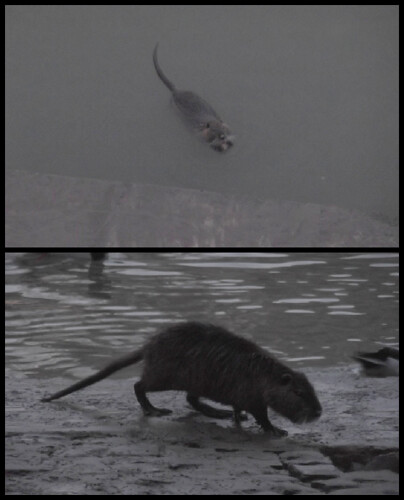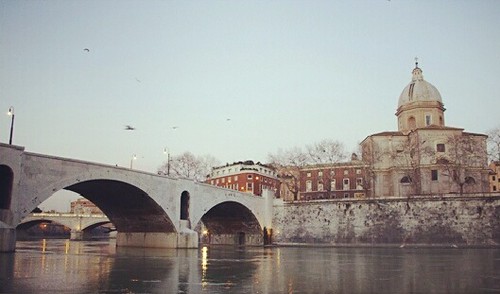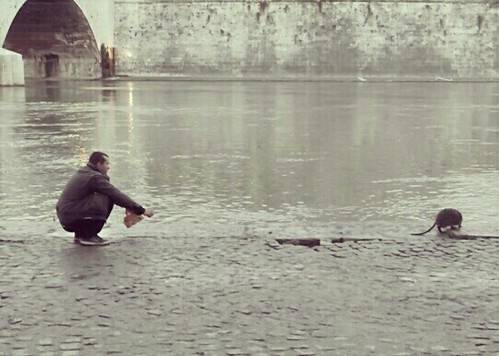After deciding to head to the Vatican late in the day, as the sun was setting and the light was low, my mother and I were distracted by some Italians pointing and taking pictures over the wall that bordered the Tiber River. Although I didn’t understand the rush of all the Italian words I was hearing, I could tell they were looking at something unusual by the way they exclaimed, Per carita! (No way!) Guardi! Vedete quello che vedo io? (Look! Do you see what I see?). As we looked to see what had caught their attention, we saw three creatures swimming amongst the ducks, and scurrying around on the stone surface beneath us. “Are those giant rats?” my mother exclaimed. The animals fit the features of a rat with their long hairless tails, but something about them was different - other than the fact that one was nibbling on a piece of pizza. Like everyone else in Rome, even these rat-like creatures liked pizza. One may be led to believe they even were otters, based on their size, if one didn’t bother to get a closer look.

Walking down the step steps toward the riverside, I cringed, as the stench of urine, grimy trash, and rotting food hit my nose. I carefully picked my way down among the trash and food scraps lying around. The Tiber River was a murky brown color, not at all inviting for swimming or fishing. I looked up at the beautiful, old bridge and surrounding ancient buildings to take my mind off these not so pleasing elements. Tiptoeing around the garbage on my way down the smooth, stone steps leading from the street level to the river, I angled to get a closer look at these creatures that were yet to be identified.

A fisherman held out a piece of pizza, trying to lure one of the giant rat-like creatures over for a snack. I was not surprised that pizza was what the fisherman was offering because I knew there was no shortage of pizza here in Rome, after standing behind a counter myself that very afternoon trying to pick a type of pizza to eat. There were more kinds of pizza than I knew even existed in front of me, and the one I chose was well worth the time spent on my decision. Although I still have no idea what was on the pizza, I didn’t mind - I just knew I was tasting many wonderful flavors somehow all put onto one slice of pizza. But I digress…one of the creatures approached the fisherman and took the piece of pizza, but quickly retreated to the water. Unfortunately, it didn’t have multiple choices in the pizza toppings, like I did. However, I could tell the pizza was still enjoyable for the creature because as it ate I could see the whiskers moving around as it chewed. The animal reminded me of a raccoon, in the way it held and munched on the piece of pizza.

We weren’t the only people curious to see these creatures up close. Other Italians that passed by also took pictures, so we figured perhaps these large rats were not such a common sight.
The next day, we shared our observations with other longtime Roman resident friends. They were amazed and told us they’d heard stories of the giant rats that lived in the Tiber, but they had never seen the animals. We joked that at least the creatures were too large to sneak under doorways like mice, but that they’d have to ring the doorbell to enter anyone’s home.
Upon doing research, I found that these creatures, called nutria, are not muskrats which are native to the U.S., but are originally from South America. They are a cousin of the beaver and were introduced around the world for their fur, which is under the wet coarse, unappealing hair we observed. The nutria, also known as copyus, tend to stay hidden, so we were lucky to get a photograph. They were introduced to Italy in farms to be raised commercially, but some escaped into the wild. However, they are viewed as pests because of their destructive feeding and burrowing behaviors.
In Spanish speaking countries, the word nutria refers to otter. However, the name coypus is used in Latin America and Europe, to avoid confusion with actual otter. Muskrats are very similar in appearance and size to nutria. Muskrats are the largest species in the rodent family related to voles and lemmings. Muskrats can be up to 16–28 inches in length, although almost half of that is tail. Muskrats weigh from 1.3–4.4 lbs., about four times the weight of the brown rat. Nutria are even larger than muskrats; their tail alone can be 16 inches and their bodies up to 25 inches in length with a weight four times that of muskrats, 15 to 22 lbs. The snout of the nutria is much larger, and broader, a different shape than that of muskrats as well.
I didn’t expect to see a new species of wildlife in Italy, but the pizza-eating nutria were a nice diversion from the architecture, art, and ancient Roman ruins. The nutria choose a good place to live because everyone eats well in Rome.
Sydney Kahl is a member of the Youth Travel Blogging Mentorship Program.
All photos courtesy and copyright Sydney Kahl
Are Those Giant Rats?
